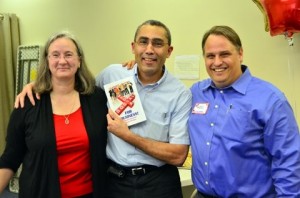

I happened to look in my rear view mirror to see a black Mercedes sedan zoom up behind me then pass. It shot around me at an extremely high rate of speed and was soon out of sight. “Wow, where’s the fire?” I though. A few minutes later as I was about to make my final right turn off the main highway, the same black Mercedes shot out of the intersection I was about to turn into. It turned left and roared past me, heading west  toward Tehran.
toward Tehran.
I took my foot off the accelerator, my stomach feeling queasy with deep apprehension. I had caught a glimpse of the driver’s face with dark glasses and thick mustache. It seemed vaguely and ominously familiar. I slowed the car and idled toward the vacant lot where I was to meet Junior, afraid of what I might find. I could see Junior’s old Peykan in the distance, the driver’s door open. I was sure I saw him move and at first I thought he was about to get out of the car, but as I got closer I could see Junior’s body suddenly fall forward against the steering wheel, sounding the car’s horn.
“Oh no! Please God! Oh no! This can’t be!” I said over and over. “Oh Jesus, no!”
I pulled my car alongside his. My knees were shaking as I got out of the car, and walked toward Junior. As I approached, I could see the back of his head was covered with blood. He had been shot, execution style. I pulled his torso off of the steering wheel to stop the horn from sounding, and then I lifted his left arm to feel his wrist. I thought I detected a faint pulse, but then a few seconds later, it stopped.
The only pulse I could feel now was my pounding heart, ready to burst through my chest. Flooded with a mixture of fear and sadness, I tried to ponder what to do next.
“We’ll need to notify his wife,” I remember thinking. I started searching his pants for a wallet with an ID, but I found nothing. The only thing I found was a large roll of bills in the left pocket of the old tweed jacket that Junior always wore. My hands were shaking.
“My god, this is a lot of money! His wife is going to need this,” I thought as I crammed it into the pocket of my fatigue jacket. I looked across the vacant lot to see an old man who was walking with a shuffled gate toward me from one of the distant houses. I waited for him as he approached. When he came up to the car, he was shaking his head.
He looked at me, quizzically. “SAVAK?” he asked.
I nodded. “Bali Agah. SAVAK.”
The old man started shaking his head again. “Shah very bad. Very bad man.”
I nodded. The old man and I stood together in silence appraising the ghastly scene.
“You want me call police?” he asked.
“Yes, you call the police. Don’t tell them I was here,” I said in my best Farsi.
“I no tell. We see nothing.”
At that moment we heard a siren somewhere in the distance growing louder.
“I need to leave now,” I said.
“You go! Boro! Boro! Zud bash!” (Go! Go! Hurry!) exclaimed the old man waving me away vigorously with his hands.
I stepped away from the old man and got into my car, knees and hands still shaking. I turned the key in the ignition and headed out to the main highway by first going around the block. I waited until I heard the siren stop and then proceeded. As I drove, I kept checking the rear view mirror, side streets, and intersections for any sign of a black Mercedes. But it had done its dirty work and was long gone. When I got back to the Teamhouse, I unloaded my car and took the goods up to my room. The boxes seemed incredibly heavy and my shaking knees complained at the load as I came up the stairs the last time. When I had finished, I collapsed into my bed and started sobbing again. “Junior, I am so sorry man,” kept repeating as though he could hear me.
I looked at the huge roll of cash, and was suddenly struck with an irrational fear that Lou might think I was trying to cheat him. I counted out what I felt Junior would have paid him that day and put it in an envelope, then slipped it my desk drawer. I took out a sheet of paper, and scrawled simply, “Lou, bad news. Junior’s dead. SAVAK shot him.” I placed the note on the desk where he could find it then walked downstairs to my car.
I dreaded having to tell Fari what happened, but forced myself to the car. When I walked into the house minutes later, Fari emerged from her room to meet me and immediately stepped back. “Oh my god, Doug! What happened? Your eyes are all red!”
“Fari, Junior’s dead. SAVAK shot him in the…in the…back of the head,” I said with my voice breaking.
Fari put her arms around me and held my while I continued to weep. “Doug, this is awful.”
I put my face down onto Fari’s shoulder. “Junior was a good person,” I said through my tears. “He didn’t deserve to die.”
__________________________________________
The Man Who Fooled SAVAK, a suspenseful romance, is available on the Kindle, the NOOK and in other ebook formats from Smashwords.com.
Electronic Edition
eIBSN 978-1-4524-4281-5
435 Pages
Published June 2011
Martin Brossman and Anora McGaha know how to launch a book. Over 50 people attended the event on Aug. 4 celebrating the launch of Social Media for Business, a comprehensive anthology focused on small business and the power of social media. More than 35 books were sold with some guests buying two and three copies. The launch was held at the Center for Excellence, a training and speaker center in North Raleigh, NC.
Social Media for Business is available on Amazon and fine bookstores everywhere.
For more information about Social Media for Business, visit the book web site.
 RALEIGH, NC – Martin Brossman and Anora McGaha, co-authors of Social Media for Business, an Outer Banks Publishing Group book, held a “book launch” on Thursday, August 4 at The Center for Excellence on Six Forks Road South in Raleigh, North Carolina.
RALEIGH, NC – Martin Brossman and Anora McGaha, co-authors of Social Media for Business, an Outer Banks Publishing Group book, held a “book launch” on Thursday, August 4 at The Center for Excellence on Six Forks Road South in Raleigh, North Carolina.
Celebrating Mr. Brossman’s third social media book, and Ms. McGaha’s first book, the authors offered door prizes at the event including a social media consultation by Martin Brossman & Associates and a Kindle ebook reader. Catering for the event was by Catering by Design.
Mr. Brossman’s first book on social media, Brossman’s Social Media and Online Resource Directory for Business, had a North Carolina focus. Mr. Brossman said he received overwhelming feedback from his readers to produce a national, more comprehensive version that would cover the entire spectrum of social media and its use in business.
For Social Media for Business, Mr. Brossman partnered with Ms. McGaha, a social media manager and Internet researcher, to write and edit the book. They included chapters from twenty contributors to deepen the coverage and expertise, covering audio and video, mobile, Facebook and LinkedIn ads, articles, press releases in addition to dozens of other topics.
Social Media for Business includes a section on perspectives about social media and Internet marketing with a rich collection of articles; a large central section on the building blocks of social media and the Internet; and a substantial section on online marketing through social media. Visit the Social Media for Business web site for more information.
“Social Media for Business is particularly valuable for the micro-business and solo professional, as well as small businesses with under 25 employees because it was written by micro-business and solo professionals who bring their own fresh experience and research,” said Ms. McGaha. “Readers will learn about building, establishing and maintaining a strong, genuine, appropriate multi-dimensional presence for their business on social media and other Internet channels.”
Mr. Brossman, who has been using and teaching LinkedIn since 2006, and is the leading trainer of social media and business success for small businesses in North Carolina, brings fascinating insight and perspectives to the book.

Mr. Brossman’s second social media book, Linking Into Sales, was written with fellow LinkedIn expert and community builder Greg Hyer, to show readers how to use LinkedIn to increase sales.
“My personal and professional mission is to help individuals live lives so meaningful it moves them and others to tears,” Mr. Brossman said. “Extending out from that, it is to help micro-business thrive for a grassroots rebuilding of the American economy. This book sets out to give a solid and motivating push for small businesses to use social media and online marketing to be successful in business.”
The audience for Social Media for Business is both the newcomer to social media and online marketing, as well as the experienced practitioner. “Each reader will take out different insights based on their experience and needs,” said Ms. McGaha.
“I don’t think there is a single book on the market that covers so expertly every aspect of social media,” said Anthony S. Policastro, Publisher of Outer Banks Publishing Group. “And what makes this book so valuable is that the contributors provided honest and frank viewpoints on their particular expertise based on actual experience. It’s like being in a room with all of them and they are telling me the best practices and techniques to be successful using social media.”
Anora McGaha is a writer and author, with three years of experience in social media management and Internet research. Prior to that her career spanned twenty years in marketing communications and business analysis. She provides training and consulting on Internet publicity, social media and online marketing and is an associate with Martin Brossman & Associates and Carolina Web Consultants, Inc. For more information visit her Linkedin site.
Martin Brossman is a success coach, speaker, trainer, and author specializing in teaching social media and business success to accelerate growth for entrepreneurs and small businesses. He’s the founding director of Martin Brossman & Associates and collaborates with micro-business and solo-professionals in delivering the latest training and services. He is the author of three books on social media; travels and trains frequently; and is a powerful keynote speaker on dozens of relevant topics. An early user of LinkedIn, Brossman has built a meaningful and significant network of his own. For more information see his Linkedin site.
Photos of the event can be seen on the Social Media for Business Facebook page.
Social Media for Business is available directly from the printer at a discount of $16.50. Use the discount code of “EJUCVT36” at checkout to get a $6.45 discount off the list price for a sale price of $16.50. The book is also available on Amazon, Barnes & Noble and other fine bookstores.
When I heard this sad story on NPR radio this morning it moved me so much and reminded me of Doug Roberts novel, The Man Who Fooled SAVAK, a suspenseful love story based on true events. This is the kind of repression that still pervades a lot of the Middle East today as it did forty years ago when Mr. Roberts staged the successful escape of his fiancé and her mother from a repressive and threatening Iran.
In January of this year in Pakistan, the governor of Punjab province, Salmaan Taseer, who was an outspoken defender of civil rights, was gunned down for criticizing the hardness of Islamic law. He was merely sticking up for a Christian woman who was accused of blaspheming Islam. Her punishment: death.
His daughter, Shehrbano Taseer, is a journalist in Pakistan, and she talks to Steve Inskeep, host of NRP Radio’s Morning Edition, about her father’s legacy and her own fight against extremism.
Here is part of that interview:
“INSKEEP: And it was not that your father committed this alleged act of blasphemy, but merely spoke up for the rights of someone who was accused of blasphemy and asked for her to be accorded mercy. This is what many clerics described as itself being blasphemous.
Ms. TASEER: Yeah, because my father had criticized the law. He had criticized the misuse of the law.
INSKEEP: Did anyone speak up for your father after his murder?
Ms. TASEER: There were three people who believed that this law was being misused and that this was an unfair  allegation of blasphemy. There was my father. There was our federal minister for minorities, Shahbaz Bhatti, and there was Syeda Imam, who is a parliamentarian. And she had tabled a bill in the national assembly trying to water down this law and stop the misuse. And two out of three of these people are now dead. Shahbaz Bhatti, our federal minister for minorities, was gunned down outside his mother’s home two months after my father was shot dead.”
allegation of blasphemy. There was my father. There was our federal minister for minorities, Shahbaz Bhatti, and there was Syeda Imam, who is a parliamentarian. And she had tabled a bill in the national assembly trying to water down this law and stop the misuse. And two out of three of these people are now dead. Shahbaz Bhatti, our federal minister for minorities, was gunned down outside his mother’s home two months after my father was shot dead.”
You can read the rest of this moving interview or listen to it on the NPR site. And if you want to read more about a similar story with a much different outcome, download a copy of The Man Who Fooled SAVAK, available on the Kindle, Barnes and Noble NOOK, Apple iBooks and in various ereader formats from Smashwords.
Congrats to Amanda Hocking for using a traditional publisher to further her writing career. She did the right thing seeking out a traditional publisher and the reason is clear – she wants to be a writer – not a book marketer, editor, designer and distributor.
 This is not a new trend – it has been happening for years.
This is not a new trend – it has been happening for years.
The caveat here is her content. She has the content that sells – when she writes, it sells. She can afford to give away a large piece of her royalties so she can spend more time writing.
So should every self-published author seek out traditional publishers for their work. Maybe, yes and maybe, no. Some authors like JA Konrath took the reverse course – he went from traditional publishers to self-publishing because he could get a bigger piece of the publishing pie, especially on his traditionally-published books that went out of print. Even luminary Stephen King experimented with self-publishing a few years back.
A new trend is emerging as traditional publishers go digital. Currently, a self-published author could get their work in front of more people as an eBook than a printed book. This is still true, but as more and more traditional publishers go digital, they can offer both – significant eBook exposure as well as print book distribution. They will take a larger piece of the pie, but if your work is selling well, it is worth going with a traditional publisher.
Here’s the Amanda Hocking story from The New York Times.
If any writer proved that modern self-publishing could be a pretty sweet deal, it was Amanda Hocking.
Amanda Hocking, who has self-published nine books.
In the past year Ms. Hocking, a 26-year-old from Minnesota, became an indie heroine in the literary world for publishing nine books that sold a total of more than one million copies, nearly all of them in e-book form, earning almost $2 million for her efforts.
But for Ms. Hocking, self-publishing has had its limits. On Thursday she announced that she had sold a four-book series to St. Martin’s Press, ending a frenzied weeklong auction that involved nearly every major publisher in the business, including Random House, Simon & Schuster and HarperCollins.
St. Martin’s, part of Macmillan, paid more than $2 million for the world English rights to the “Watersong” series, Ms. Hocking’s latest books in the young-adult paranormal genre. >more
As more and more authors turn to self-publishing, a new trend is emerging that may benefit publishers as well as authors.

Successful crime novelist Joe Konrath is probably the author who started this new trend and is the poster child of successful authors moving into the self-publishing realm.
According to an article in The Star-Telegram online written by Alex Pham of The Los Angeles Times,
“Joe Konrath can’t wait for his books to go out of print.
When that happens, the 40-year-old crime novelist plans to reclaim the copyrights from his publisher, Hyperion Books, and self-publish them on Amazon.com, Apple’s iBooks and other online outlets. That way he’ll be able to collect 70 percent of the sale price, compared with the 6 to 18 percent he receives from Hyperion.
As for future novels, Konrath plans to self-publish all of them in digital form without having to leave his house in Schaumburg, Ill.
‘I doubt I’ll ever have another traditional print deal,’ said the author of Whiskey Sour, Bloody Mary and other titles. ‘I can earn more money on my own.'”
Mr. Pham goes on to write, “It’s difficult to gauge just how many authors are dumping their publishing houses to self-publish online, though for now, the overall share remains small. But hardly a month goes by without a well-known writer taking the leap or declaring an intention to do so.”
However, Mr. Konrath is one of the exceptions to successful self-publishing because his fan base was primarily created by the marketing and distribution efforts of traditional publishing houses.
Does that mean an author needs to be published by a traditional publishing house to be successful later in self-publishing?
Not at all.

Mr. Konrath just stood up on his surf board and is about to catch one of the largest new waves in publishing. He knows where his readers are and how to read them – online where most hang out.
As an aspiring or first-book author who is relatively unknown, you need to market your work to where people seek, read, recommend and review books – in social media: Facebook, Twitter, NING, Linkedin, Foursquare, Goodreads, and all the other social networking sites out there.
There is only one problem. By the time you learn how to effectively market your work on all the social media, you may be in an old-age home especially if you are not so computer savvy. Besides, when would you have time to write another book?
Most authors just want to write. They don’t want to wear six or seven hats and be the marketing guru, the sales superstar or the promotional genius.
This is where publishers can get their own surf board and ride the same wave as Mr. Konrath. But some are just standing up on their boards, others are knelling and most don’t even see the social media wave.
Publishers can offer social networking services, electronic distribution and all the perks of traditional publishing to authors in digital and electronic form. This is a wave that is coming whether publishers like it or not so the best strategy is to make sure to have a surf board and to look out over the horizon. This publisher is certainly standing on his surf board poised to ride the next giant wave.
It was only a matter of time. Did you think Amazon would sit back and let Apple steal its thunder from the Kindle? I predict based on the following New York Times blog post, that we will see an iPad-like device from Amazon by the end of this year or early next year. What do you think?
From The New York Times blog, Bits, May 17, 2010, 3:42 pm
By NICK BILTON
Since Apple announced its plans for the iPad, Amazon has shared few details about how it would respond to the competition for its Kindle. But over the last few weeks, it has offered some more clues.
Lab 126, the division of Amazon responsible for building the Kindle, has been on a hiring binge, with dozens of new job listings on its Web site. Some are positions for testing and readying new products. And this suggests that the company might be preparing a new device. More >>
Ok, if you think this idea is off the wall consider this: if a programmer leaves out a single character or adds an extra character, the program will not work as intended.
Writing in essence is the same. If you don’t craft your words, sentences and paragraphs properly, your intended message does not come across.
Programming is a lot easier than writing – it’s exact – XYZ code tells the computer to execute a specific function. The computer does not have an opinion about the code and the code does not have several meanings.
Writing, on the other hand, is more complex. Words have different meanings for different people. The structure of a sentence or paragraph may have one meaning for one person and different meaning for another.
But if the writing has the right flow, the right words and the right structure it is like great poetry. That’s why we hear statements like, “The writing works! The writing pulls you in! I just love the writing!” It is the stuff of the classics and more.
So what exactly is the right stuff – the stuff of classics, the magic of the writing? My take is that the writing communicates universal truths, truths that are common and important to all human beings. The universal appeal of these truths is so powerful that the writing lives on generation after generation, century after century.
More importantly, the writing drips with emotion. Words can stir our deepest hopes and dreams, our imaginations, our inspirations and they let us dance in the joy of the things we love.
It’s not easy getting words to do all those things, but as writers we always try. So if you can get the right “programming” for your words, you will write a classic that will live on and on.
Try doing that with a computer.